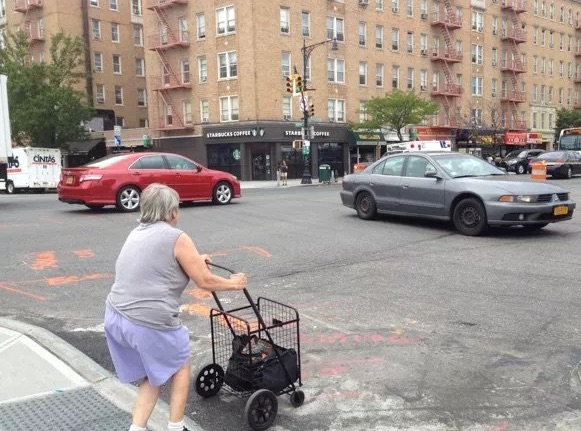Drivers killed three people walking in NYC on Tuesday. Two of the victims were seniors. Overall, people 65 and older make up 13 percent of the city's population but account for nearly half of the pedestrian fatalities this year, according to Transportation Alternatives.
At approximately 9 a.m. yesterday, Eugene Kouassi hit Carmen Velez, 81, with an SUV while making a left turn onto E. Fordham Road from Hughes Avenue in the Bronx, the Daily News reported.

Velez sustained body trauma and died at St. Barnabas Hospital, according to NBC. Police charged Kouassi, 51, with violating the victim’s right of way and careless driving.
Velez was killed three hours after a motorist fatally struck 71-year-old Joseph Ranieri on Meeker Avenue in Brooklyn. No charges were filed against the driver, whose name was shielded by police.
The third victim, an unidentified woman reportedly in her fifties, was hit by the driver of a pickup truck on Gerritsen Avenue and Whitney Avenue in Gerritsen Beach. No charges were filed.
Also yesterday, a yellow cab driver critically injured an 87-year-old man on Grand Street in Manhattan. “Cops say the victim was jaywalking,” the Lo-Down reported. “The driver has not been charged with any crime.”
As of yesterday, motorists had killed 22 people walking on NYC streets this year, according to TA. Of 21 victims whose ages were reported, 10 of them -- 48 percent -- were 65 or older. The toll during the first two months of 2017 highlights a longstanding fact: NYC seniors are especially vulnerable to traffic violence.
[Update, March 10: The victim whose age wasn't known was 90. As of this week half of all pedestrians killed in 2017 were age 65 and over.]
"Senior pedestrians are killed in numbers far disproportionate to their share of the population," said TA Policy and Research Manager Julia Kite in an email. "Crashes that young people might survive could easily be fatal to senior citizens, who also suffer more serious and even fatal complications from injuries such as fractures."
Streets designed to slow motor vehicle traffic and consistent enforcement of the most dangerous moving violations are key to a safe walking environment. Yet NYPD and the press routinely point fingers at seniors who are injured and killed by motorists. "We don't believe victim-blaming is acceptable for any age group," said Kite, "but we see a lot of it for seniors in particular -- as if getting older, losing a degree of mobility, or having a slower reaction time somehow makes a pedestrian at fault for the actions of a reckless driver."
Wide streets built to facilitate fast driving force seniors to quickly cross multiple lanes of traffic, leading to crashes like the one that killed Feliks Dadiomov on Ocean Parkway in January -- a collision NYPD and the media blamed on the 88-year-old victim.
"The solution isn't to put reflective tape on canes and walkers," said Kite, referring to a practice NYPD has taken to publicizing as a Vision Zero tactic. "It's to re-engineer streets to stop drivers speeding and violating right-of-way. Unsafe streets not only kill seniors, but they intimidate and isolate them as well, worsening their quality of life when they should have every right to the city."
Kite notes that seniors are encouraged to keep active physically and socially, but that's "difficult to do when you see people in your age group repeatedly being killed while doing nothing wrong."






